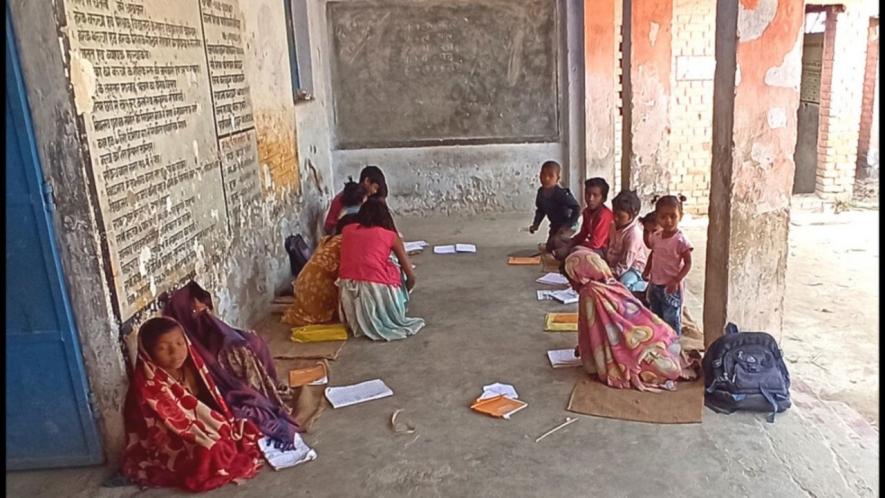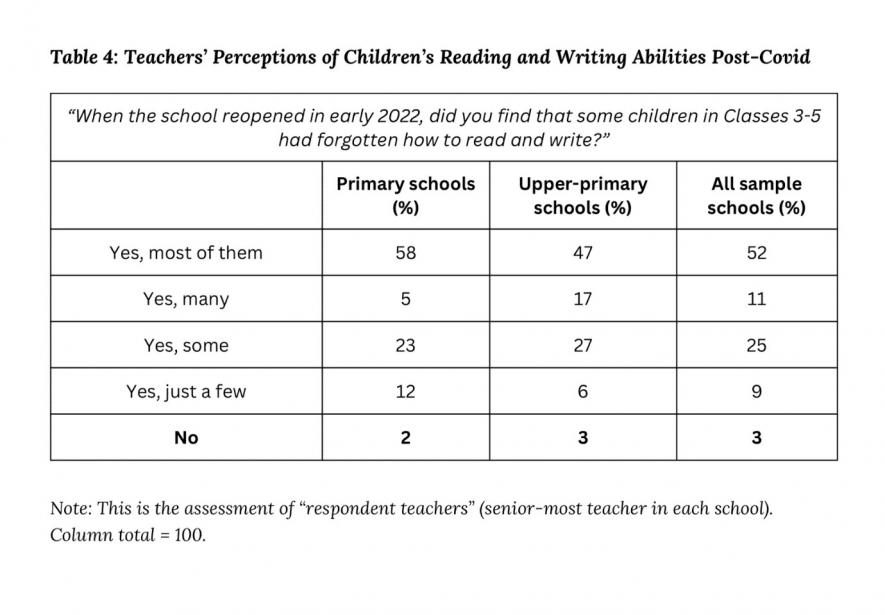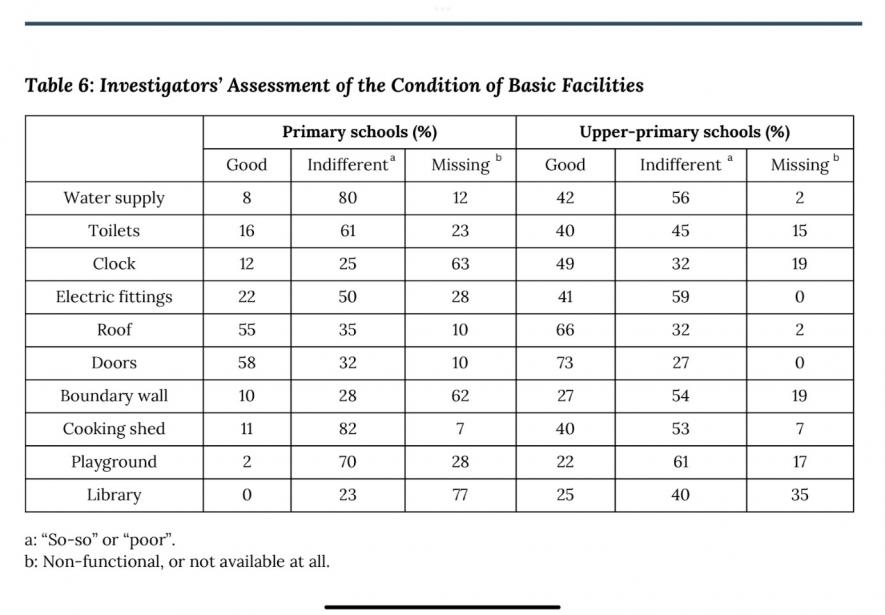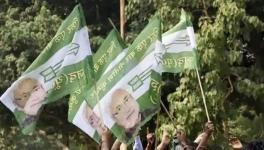Bihar: Survey of Govt Schools in Araria, Katihar Depicts Grim Post-Pandemic Picture

A survey of the public schooling system of Bihar has painted a grim picture post-pandemic. The survey, carried out by Jan Jagran Shakti Sangathan (JJSS) found a huge gulf between Right to Education (RTE) Act guidelines and the actual number of teachers in these schools with a high level of teacher absenteeism reported in the schools.
The report, titled “Where Are the Kids?: The Curious Case of Government Schools in Bihar” by Paran Amitava and Kanika Sharma on JJSS analysed the effects of the COVID-19 period on public school education by surveying 81 primary and upper primary schools in Bihar’s Araria and Katihar districts early in 2023.
The survey involved team visits to primary and upper primary schools with at least 50% enrolment of students from socially disadvantaged groups (SC, ST, OBC, Muslim backgrounds) to make a fairly representative sample of schools that can be accessed by socially disadvantaged children.
Where are the Teachers?
The report, released in A.N. Sinha Institute in Patna on Friday, found that while the RTE Act states that for every 30 students there should be one teacher, 95% of upper-primary schools and 65% of primary schools violated this norm. In fact, the existing teachers also struggled with the shortage of teachers, as it left many students unattended and increased their workload. The 81 sample schools were short of a total of 582 teachers as per the RTE guideline, said the report.
Another major issue highlighted in the report is the high levels of teacher absenteeism. On an average, merely 63% primary teachers and 55% upper primary teachers were found on the school premises during the survey team’s visits. “When combined, these statistics reveal a grim picture that in real terms, effective teacher presence amounts only for 42% and 23% in primary and upper primary schools, respectively,” it said.
The presence of over 40% women teachers and many teachers from Scheduled Castes, Scheduled Tribes, Other Backward Classes or Muslim backgrounds has been recognised as a silver lining for these school’s students as it is a step toward overcoming social distance from the formal education system, the report pointed out.
Routine Overreporting of Pupil Attendance
The survey team, which collected attendance data using two methods-checking the attendance records and doing a physical count of present students, found that the difference between the registered attendance and the actual number of students was huge.
“This survey found that pupil attendance in primary schools was as low as 44% according to the registers, and even lower - only 23% - based on a direct count. The corresponding figures for upper-primary schools were similar: 40% and 20% respectively. As shown in Table 3, only two percent of schools (in primary and upper-primary both) reported attendance of 60% or above,” it said.
The report said that this gulf was created by a common practice of teachers “overreporting” actual attendance. This “alarmingly low attendance” couldn’t be attributed to seasonal effect as the survey period did not coincide with any major festivals or agricultural activity, it added.
Learning Losses in Lockdown
Many reports have documented the major educational losses incurred especially by underprivileged children in the wake of the Covid-19 period and lockdown. When the surveyors of this report asked teachers if students enrolled in grade 3-5 had forgotten how to read and write during this period, the answer was a resounding ‘yes’.

The report pointed out that “such a serious learning gap” required serious remedial measures to overcome it. However, it found that little effort had been made in this respect.
As many as 85% respondents informed the survey team that their schools did not extend school hours once they reopened post-pandemic. Merely 1/5th of primary and 1/3rd of upper primary schools held extra classes outside regular school hours. Many bridge courses were introduced and left midway. “The significant gaps in foundational learning serve to further intensify the existing educational inequalities, as marginalised students from rural areas were disproportionately disadvantaged,” the report noted.
Under the New Education Policy 2020, a set of books for grades 1-3 were introduced as a part of Foundational Literacy and Numeracy (FLN) coursework, which aims at teaching basic arithmetic, reading and writing to children. However, the survey found that 28% of the sample schools had not been provided with these books that could have helped bridge the learning gaps.
Poor Infrastructure
The schools surveyed in the North Bihar region were found lacking in basic amenities, such as boundary walls, playgrounds, toilets for girls and boys and supply of clean drinking water.

Another shocking fact uncovered in the survey was that of many schools functioning without any building.
The RTE Act mandates that the school building should be located within 1 km of the locality for which it functions. However, 9% of the sample schools were found to have no building. These schools are running within other government offices or buildings. Due to this reason, they are often located far away from the communities, which further dwindles student enrolment and attendance and parents worry about sending children long distances without any adequate provisions of safety and transport, the report noted.
Mid-day Meals Scheme
Children enrolled in primary and upper primary schools have the right to a hot-cooked midday meal under the National Food Security Act. However, the survey found that 20% of the sampled schools reported inadequate funds for running the scheme, many schools did not have a proper cooking area or supply of clean water to ensure hygienic mid-day meals.
Also, many schools were found “imposing ideas of vegetarianism” upon the marginalised students by way of promoting leaders who propound brahminical vegetarianism, the report noted, adding that due to this, many students did not receive eggs in their meals.
Direct Bank Transfer Problem
Before 2017, the task of providing textbooks and uniforms to school children was carried out in a centralised-distribution system by the Department of Education. However, Direct Bank Transfer (DBT) replaced this system. The efficacy of DBT can be gauged from the fact that many children simply did not have uniforms and textbooks, said the report.
The survey team found that cash transfers were often being used for other necessities by poor families. Incidentally, DBT is subject to the condition of 75% school attendance and requirement of an Aadhar-linked bank account. But, many people reported failure of transfers due to problems in Aadhar linking, or due to technical discrepancies, the report said.
Even Bihar government’s own data on the Medhasoft portal shows that over 10,000 students’ bank accounts were rejected in 11 survey blocks, it added.
The report pointed out that many students were deprived of uniforms and textbooks, with many students who received the DBT funds saying they used it to pay for private tuition.
“The growing trend towards private tuitions reinforces existing socio-economic inequalities as quality education becomes a commodity for those who can afford it,” the report pointed out.
Get the latest reports & analysis with people's perspective on Protests, movements & deep analytical videos, discussions of the current affairs in your Telegram app. Subscribe to NewsClick's Telegram channel & get Real-Time updates on stories, as they get published on our website.
























